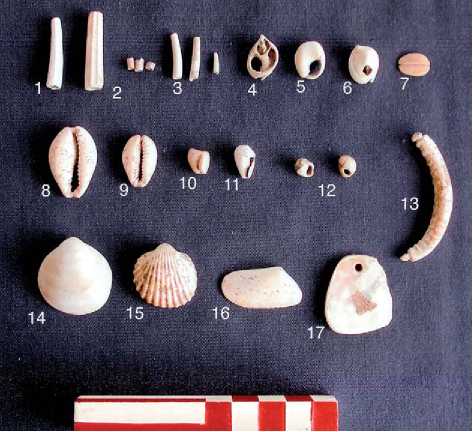The earliest evidence for use of mollusks by humans is from burial contexts of early modern humans (Skhul and Qafzeh caves, Israel) dating to about 100 000 years ago. Marine shells, especially small gastropods (such as Nassarius and Columbella) and bivalves (such as Glycymeris and Cerastoderma) and Dentalium (sca-phopods) were the preferred species for decoration throughout the Upper Palaeolithic in parts of Europe, the Near East, and North Africa (Figure 2). In South Africa Nassarius was also a preferred genus during the Middle and Late Stone Age, while Dentalium was used in the Late Pleistocene of western Australia.
Shell, being relatively easy to obtain from the beach or from freshwater sources, and made of a relatively soft material (hardness: 3 on the Mohs scale) is a preferred source for making ornaments to this day.

Figure 2 Selection of shell ornaments from Palaeolithic and Neolithic sites: 1,2. Dentalium sp.; 3. Antalis spp. (six specimens); 4-6. Nassarius gibbosulus; 7. shell artifact of unknown species; 8. Cypraea spurca; 9. Cypraea erosa nebrites Red Sea; 10. Colum-bella rustica; 11. Conus mediterraneus; 12. Theodoxus jordanii (two specimens); a freshwater species; 13. a worked ‘cassid lip’ of Phalium granulatum; 14. Glycymeris insubrica; 15. Acanthocar-dia tuberculata; 16. Donax trunculus; 17. pendant of Pinctada margaritifera (Photo: Daniella Bar-Yosef).
It can be used as a simple bead (i. e., a natural shell with a perforation), or it can be made into an artifact so that the initial shape is no longer recognizable. The most common personal ornaments made of shell are disc beads, pendants, and bangles. Methods for producing holes consist of grinding, gouging, drilling, hammering, a combination of those, or relying on natural perforations that are a result of abrasion. Those should not be confused with holes produced by natural predators, primarily gastropods of superfamilies: Naticacea and Muricacea.
Shell bangles made of Spondylus gaederopus from the Mediterranean occur throughout the Balkans and further areas of Europe. Bangles made of Lambis truncata were common in the Chalcolithic and Early Bronze Age of the Levant, and similar bangles made of Turbinella pyrum were common in the Bronze Age cultures of the Indian subcontinent. By contrast, Glycy-meris bangles are common phenomena among southwestern US cultures. In Central and South America ornaments and other artifacts of Spondylus sp. were desired for their red colors. Occasionally operculi (sing. operculum)of gastropods were used for ornaments as well.
Shells served as functional artifacts, such as containers (e. g., valves used as cosmetic palettes in ancient
Egypt and Mesopotamia), bailer shells used as pails, digging tools, fishing hooks, musical instruments (and especially trumpets made of Charonia tritonis and other large gastropods).
Shells were used as currency in different parts of the world in different periods. To serve in this function the shells have to answer several criteria: to be durable, hard to forge, easily identifiable, not too easy to obtain, and their value needs to be agreed upon. The best-known examples are from Bronze Age China where cowries were used as shell money, California - where Dentalium served in this capacity, and Cypraea moneta (cowrie) that originated in the Maldives served Europeans to buy slaves in western Africa during the seventeenth-eighteenth century. In the northeastern US wampum belts made of Mercenaria and Busycon also served as currency, especially during postcontact fur trade. Busycon served to produce many other shell artifacts, including shell gorgets.
Studying shell artifacts throws light on past economies as expressed in ancient trade routes and exchange systems, and it testifies to past spiritual lives as evidenced in funerary customs and other rituals.




 World History
World History









